Hydrological Implications of Recent Droughts (2004–2022): A SWAT-Based Study in an Ancient Lowland Irrigation Area in Lombardy, Northern Italy
Abstract
:1. Introduction
2. Materials and Methods
2.1. Study Area
2.2. Application of the SWAT
2.3. Calibration and Validation of the Model
2.4. Trend Analysis
2.5. Soil Moisture Sensors
3. Results
3.1. Input Data Analysis
3.2. Calibration and Validation of the Model
3.3. Model Results
3.4. Soil Moisture Sensor Results
4. Discussion
5. Conclusions
Author Contributions
Funding
Institutional Review Board Statement
Informed Consent Statement
Data Availability Statement
Acknowledgments
Conflicts of Interest
References
- Giorgi, F.; Im, E.S.; Coppola, E.; Diffenbaugh, N.S.; Gao, X.J.; Mariotti, L.; Shi, Y. Higher hydroclimatic intensity with global warming. J. Clim. 2011, 24, 5309–5324. [Google Scholar] [CrossRef]
- Egidio, E.; Mancini, S.; De Luca, D.A.; Lasagna, M. The Impact of Climate Change on Groundwater Temperature of the Piedmont Po Plain (NW Italy). Water 2022, 14, 2797. [Google Scholar] [CrossRef]
- Forootan, E.; Sadeghi, S.H.R. Relative importance of climatic and anthropogenic factors on runoff change at watershed scale. Int. J. Environ. Sci. Technol. 2023, 20, 3059–3070. [Google Scholar] [CrossRef]
- Kuwayama, Y.; Thompson, A.; Bernknopf, R.; Zaitchik, B.; Vail, P. Estimating the impact of drought on agriculture using the U.S. Drought Monitor. Am. J. Agric. Econ. 2019, 101, 193–210. [Google Scholar] [CrossRef]
- Wilhite, D.A.; Svoboda, M.D.; Hayes, M.J. Understanding the complex impacts of drought: A key to enhancing drought mitigation and preparedness. Water Resour. Manag. 2007, 21, 763–774. [Google Scholar] [CrossRef]
- Ding, Y.; Hayes, M.J.; Widhalm, M. Measuring economic impacts of drought: A review and discussion. Disaster Prev. Manag. 2011, 20, 434–446. [Google Scholar] [CrossRef]
- ISAC. CNR MEAN TEMPERATURE—Latest Month Analysis. Available online: https://www.isac.cnr.it/climstor/climate/latest_month_TMM.html (accessed on 10 July 2023).
- Straffelini, E.; Tarolli, P. Climate change-induced aridity is affecting agriculture in Northeast Italy. Agric. Syst. 2023, 208, 103647. [Google Scholar] [CrossRef]
- Freire-González, J.; Decker, C.; Hall, J.W. The Economic Impacts of Droughts: A Framework for Analysis. Ecol. Econ. 2017, 132, 196–204. [Google Scholar] [CrossRef]
- Walker, W.R. Guidelines for Designing and Evaluating Surface Irrigation Systems; FAO, Ed.; FAO: Rome, Italy, 1989; ISBN 92-5-102879-6. [Google Scholar]
- Balestrini, R.; Delconte, C.A.; Sacchi, E.; Buffagni, A. Groundwater-dependent ecosystems as transfer vectors of nitrogen from the aquifer to surface waters in agricultural basins: The fontanili of the Po Plain (Italy). Sci. Total Environ. 2021, 753, 141995. [Google Scholar] [CrossRef]
- De Caro, M.; Perico, R.; Crosta, G.B.; Frattini, P.; Volpi, G. A regional-scale conceptual and numerical groundwater flow model in fluvio-glacial sediments for the Milan Metropolitan area (Northern Italy). J. Hydrol. Reg. Stud. 2020, 29, 100683. [Google Scholar] [CrossRef]
- Fumagalli, N.; Senes, G.; Ferrario, P.S.; Toccolini, A. A minimum indicator set for assessing fontanili (lowland springs) of the Lombardy Region in Italy. Eur. Countrys. 2017, 9, 1–16. [Google Scholar] [CrossRef]
- Lasagna, M.; Mancini, S.; De Luca, D.A. Groundwater hydrodynamic behaviours based on water table levels to identify natural and anthropic controlling factors in the Piedmont Plain (Italy). Sci. Total Environ. 2020, 716, 137051. [Google Scholar] [CrossRef]
- Baker, E.A.; Cappato, A.; Todeschini, S.; Tamellini, L.; Sangalli, G.; Reali, A.; Manenti, S. Combining the Morris method and multiple error metrics to assess aquifer characteristics and recharge in the lower Ticino Basin, in Italy. J. Hydrol. 2022, 614, 128536. [Google Scholar] [CrossRef]
- Neitsch, S.; Arnold, J.; Kiniry, J.; Williams, J. Soil and Water Assessment Tool Theoretical Documentation Version 2009; Report No. 406; Texas A&M Univerity System: College Station, TX, USA, 2011. [Google Scholar]
- Arnold, J.G.; Srinivasan, R.; Muttiah, R.S.; Williams, J. Large area hydrologic modeling and assessment part I: Model development. J. Am. Water Resour. Assoc. 1998, 34, 73–89. [Google Scholar] [CrossRef]
- Janjić, J.; Tadić, L. Fields of Application of SWAT Hydrological Model—A Review. Earth 2023, 4, 331–344. [Google Scholar] [CrossRef]
- Norouzi Nazar, M.; Asgari, E.; Baaghideh, M.; Lotfi, S. Quantifying the long-term flood regulation ecosystem service under climate change using SWAT Model. Ecopersia 2020, 8, 169–180. [Google Scholar]
- Mahzari, S.; Kiani, F.; Azimi, M.; Khormali, F. Using SWAT Model to Determine Runoff, Sediment Yield and Nitrate Loss in Gorganrood Watershed, Iran. Ecopersia 2016, 4, 1359–1377. [Google Scholar] [CrossRef]
- Sareshtehdari, A.; Ghafouri, M.; Ardakani, A.J.; Bayat, R. Reliability of Land Capability Map in Watershed Hydrological Simulation using SWAT Model. Ecopersia 2015, 2, 715–725. [Google Scholar]
- Arnold, J.C.; Moriasi, D.N.; Gassman, P.W.; Abbaspour, K.C.; White, M.J.; Srinivasan, R.; Santhi, C.; Harmel, R.D.; Van Griensven, A.; Van Liew, M.W.; et al. SWAT: Model use, calibration, and validation. Trans. ASABE 2012, 55, 1491–1508. [Google Scholar] [CrossRef]
- Francesconi, W.; Srinivasan, R.; Pérez-Miñana, E.; Willcock, S.P.; Quintero, M. Using the Soil and Water Assessment Tool (SWAT) to model ecosystem services: A systematic review. J. Hydrol. 2016, 535, 625–636. [Google Scholar] [CrossRef]
- Baker, T.J.; Miller, S.N. Using the Soil and Water Assessment Tool (SWAT) to assess land use impact on water resources in an East African watershed. J. Hydrol. 2013, 486, 100–111. [Google Scholar] [CrossRef]
- Xing, Z.; Ma, M.; Su, Z.; Lv, J.; Yi, P.; Song, W. A review of the adaptability of hydrological models for drought forecasting. Proc. Int. Assoc. Hydrol. Sci. 2020, 383, 261–266. [Google Scholar] [CrossRef]
- Sun, Y.; Bao, W.; Valk, K.; Brauer, C.C.; Sumihar, J.; Weerts, A.H. Improving Forecast Skill of Lowland Hydrological Models Using Ensemble Kalman Filter and Unscented Kalman Filter. Water Resour. Res. 2020, 56, e2020WR027468. [Google Scholar] [CrossRef]
- Lam, Q.D.; Schmalz, B.; Fohrer, N. Modelling point and diffuse source pollution of nitrate in a rural lowland catchment using the SWAT model. Agric. Water Manag. 2010, 97, 317–325. [Google Scholar] [CrossRef]
- Donmez, C.; Sari, O.; Berberoglu, S.; Cilek, A.; Satir, O.; Volk, M. Improving the applicability of the swat model to simulate flow and nitrate dynamics in a flat data-scarce agricultural region in the mediterranean. Water 2020, 12, 3479. [Google Scholar] [CrossRef]
- Becker, R.; Koppa, A.; Schulz, S.; Usman, M.; aus der Beek, T.; Schüth, C. Spatially distributed model calibration of a highly managed hydrological system using remote sensing-derived ET data. J. Hydrol. 2019, 577, 123944. [Google Scholar] [CrossRef]
- Odusanya, A.E.; Mehdi, B.; Schürz, C.; Oke, A.O.; Awokola, O.S.; Awomeso, J.A.; Adejuwon, J.O.; Schulz, K. Multi-site calibration and validation of SWAT with satellite-based evapotranspiration in a data-sparse catchment in southwestern Nigeria. Hydrol. Earth Syst. Sci. 2019, 23, 1113–1144. [Google Scholar] [CrossRef]
- Shah, S.; Duan, Z.; Song, X.; Li, R.; Mao, H.; Liu, J.; Ma, T.; Wang, M. Evaluating the added value of multi-variable calibration of SWAT with remotely sensed evapotranspiration data for improving hydrological modeling. J. Hydrol. 2021, 603, 127046. [Google Scholar] [CrossRef]
- Parajuli, P.B.; Jayakody, P.; Ouyang, Y. Evaluation of Using Remote Sensing Evapotranspiration Data in SWAT. Water Resour. Manag. 2018, 32, 985–996. [Google Scholar] [CrossRef]
- López, P.L.; Sutanudjaja, E.H.; Schellekens, J.; Sterk, G.; Bierkens, M.F.P. Calibration of a large-scale hydrological model using satellite-based soil moisture and evapotranspiration products. Hydrol. Earth Syst. Sci. 2017, 21, 3125–3144. [Google Scholar] [CrossRef]
- Immerzeel, W.W.; Droogers, P. Calibration of a distributed hydrological model based on satellite evapotranspiration. J. Hydrol. 2008, 349, 411–424. [Google Scholar] [CrossRef]
- ERSAF. Ente Regionale per i Servizi alla Agricoltura e alle Foreste—Regione; Lombardia. Losan Database. Available online: https://losan.ersaflombardia.it/oss/oss_index.html (accessed on 12 February 2022).
- Kottek, M.; Grieser, J.; Beck, C.; Rudolf, B.; Rubel, F. World map of the Köppen-Geiger climate classification updated. Meteorol. Z. 2006, 15, 259–263. [Google Scholar] [CrossRef] [PubMed]
- Comune di Abbiategrasso Piano di Governo del Territorio 2009, 0–33. Available online: https://www.multiplan.servizirl.it/pgtwebn/#/public/dettaglio-piano/120662/documenti (accessed on 29 May 2023).
- IUSS Working Group WRB. World Reference Base for Soil Resources 2014, Update 2015—International Soil Classification System for Naming Soils and Creating Legends for Soil Maps; World Soil Resources Reports No. 106; FAO: Rome, Italy, 2015. [Google Scholar]
- De Luca, D.A.; Destefanis, E.; Forno, M.G.; Lasagna, M.; Masciocco, L. The genesis and the hydrogeological features of the Turin Po Plain fontanili, typical lowland springs in Northern Italy. Bull. Eng. Geol. Environ. 2013, 73, 409–427. [Google Scholar] [CrossRef]
- ERSAF. Ente Regionale per i Servizi alla Agricoltura e alle Foreste—Regione Lombardia Uso del suolo in Regione Lombardia. Atlante Descrittivo. 2019, p. 51. Available online: https://www.ersaf.lombardia.it/pubblicazioni/uso-del-suolo-in-regione-lombardia-atlante-descrittivo/ (accessed on 29 May 2023).
- Perego, A.; Sanna, M.; Giussani, A.; Chiodini, M.E.; Fumagalli, M.; Pilu, S.R.; Bindi, M.; Moriondo, M.; Acutis, M. Designing a high-yielding maize ideotype for a changing climate in Lombardy plain (northern Italy). Sci. Total Environ. 2014, 499, 497–509. [Google Scholar] [CrossRef]
- Bove, M. Il Risicoltore; Ente Nazionale Risi: Milan, Italy, 2021; pp. 2–3. [Google Scholar]
- Azar, R.; Villa, P.; Stroppiana, D.; Crema, A.; Boschetti, M.; Brivio, P.A. Assessing in-season crop classification performance using satellite data: A test case in Northern Italy. Eur. J. Remote Sens. 2016, 49, 361–380. [Google Scholar] [CrossRef]
- Bux, C.; Lombardi, M.; Varese, E.; Amicarelli, V. Economic and Environmental Assessment of Conventional versus Organic Durum Wheat Production in Southern Italy. Sustainability 2022, 14, 9143. [Google Scholar] [CrossRef]
- Douglas-Mankin, K.R.; Srinivasan, R.; Arnold, J.G. Soil and water assessment tool (SWAT) model: Current developments and applications. Trans. ASABE 2010, 53, 1423–1431. [Google Scholar] [CrossRef]
- Deutsches Zentrum für Luft- und Raumfahrt (German Aerospace Center). Available online: https://www.dlr.de/EN/Home/home_node.html (accessed on 1 October 2020).
- Regione Lombardia, 2013. Basi informative dei suoli. Geoportale della Lombardi. Available online: https://www.geoportale.regione.lombardia.it/metadati?p_p_id=detailSheetMetadata_WAR_gptmetadataportlet&p_p_lifecycle=0&p_p_state=normal&p_p_mode=view&_detailSheetMetadata_WAR_gptmetadataportlet_uuid=%257BA7138B8A-9025-4802-82BC-52267B60A3D7%257D# (accessed on 1 November 2020).
- FORM RICHIESTA DATI. Available online: https://www.arpalombardia.it/temi-ambientali/meteo-e-clima/form-richiesta-dati/ (accessed on 1 October 2020).
- Uniyal, B.; Dietrich, J. Modifying Automatic Irrigation in SWAT for Plant Water Stress scheduling. Agric. Water Manag. 2019, 223, 105714. [Google Scholar] [CrossRef]
- Arnold, J.G.; Kiniry, J.R.; Srinivasan, R.; Williams, J.R.; Haney, E.B.; Neitsch, S.L. Input/Output Documentation Soil & Water Assessment Tool; Texas Water Resources Institute: Thrall, TX, USA, 2012; pp. 1–650.
- Abbaspour, K.C.; Rouholahnejad, E.; Vaghefi, S.; Srinivasan, R.; Yang, H.; Kløve, B. A continental-scale hydrology and water quality model for Europe: Calibration and uncertainty of a high-resolution large-scale SWAT model. J. Hydrol. 2015, 524, 733–752. [Google Scholar] [CrossRef]
- Abbaspour, K.C.; Yang, J.; Maximov, I.; Siber, R.; Bogner, K.; Mieleitner, J.; Zobrist, J.; Srinivasan, R. Modelling hydrology and water quality in the pre-alpine/alpine Thur watershed using SWAT. J. Hydrol. 2007, 333, 413–430. [Google Scholar] [CrossRef]
- Abbaspour, K.C.; Vejdani, M.; Haghighat, S. SWAT-CUP calibration and uncertainty programs for SWAT. In Proceedings of the MODSIM 2007 International Congress on Modelling and Simulation, Modelling and Simulation Society of Australia and New Zealand, Christchurch, New Zealand, 10–13 December 2007; pp. 1596–1602. [Google Scholar]
- Abbaspour, K.C.; Vaghefi, S.A.; Yang, H.; Srinivasan, R. Global soil, landuse, evapotranspiration, historical and future weather databases for SWAT Applications. Sci. Data 2019, 6, 263. [Google Scholar] [CrossRef] [PubMed]
- Kling, H.; Fuchs, M.; Paulin, M. Runoff conditions in the upper Danube basin under an ensemble of climate change scenarios. J. Hydrol. 2012, 424–425, 264–277. [Google Scholar] [CrossRef]
- Henry, M. Nonparametric Tests Against Trend. Econometrica 1945, 13, 245–259. [Google Scholar]
- Kendall, A.M.G. Further Contributions to the Theory of Paired Comparisons. Biometrics 1955, 11, 43–62. [Google Scholar] [CrossRef]
- Aboelnour, M.; Gitau, M.W.; Engel, B.A. A comparison of streamflow and baseflow responses to land-use change and the variation in climate parameters using SWAT. Water 2020, 12, 191. [Google Scholar] [CrossRef]
- Atta-ur-Rahman; Dawood, M. Spatio-statistical analysis of temperature fluctuation using Mann–Kendall and Sen’s slope approach. Clim. Dyn. 2017, 48, 783–797. [Google Scholar] [CrossRef]
- Ahmad, I.; Tang, D.; Wang, T.; Wang, M.; Wagan, B. Precipitation trends over time using Mann-Kendall and spearman’s Rho tests in swat river basin, Pakistan. Adv. Meteorol. 2015, 2015, 431860. [Google Scholar] [CrossRef]
- McLeod, A.I. Kendall Rank Correlation and Mann-Kendall Trend Test. R Package “Kendall”. Available online: https://cran.r-project.org/web/packages/Kendall/ (accessed on 27 November 2023).
- SNPA Cambiamento Climatico: In Lombardia, Oltre un Secolo di Dati Dall’osservatorio Milano Brera. Available online: https://www.snpambiente.it/2019/03/13/cambiamento-climatico-in-lombardia-oltre-un-secolo-di-dati-a-milano-brera/ (accessed on 10 October 2023).
- Abdullah, N.H.H.; Kuan, N.W.; Ibrahim, A.; Ismail, B.N.; Majid, M.R.A.; Ramli, R.; Mansor, N.S. Determination of soil water content using time domain reflectometer (TDR) for clayey soil. AIP Conf. Proc. 2018, 2020, 020016. [Google Scholar] [CrossRef]
- Masseroni, D.; Ricart, S.; de Cartagena, F.R.; Monserrat, J.; Gonçalves, J.M.; de Lima, I.; Facchi, A.; Sali, G.; Gandolfi, C. Prospects for improving gravity-fed surface irrigation systems in mediterranean european contexts. Water 2017, 9, 20. [Google Scholar] [CrossRef]
- Abiodun, O.O.; Guan, H.; Post, V.E.A.; Batelaan, O. Comparison of MODIS and SWAT evapotranspiration over a complex terrain at different spatial scales. Hydrol. Earth Syst. Sci. 2018, 22, 2775–2794. [Google Scholar] [CrossRef]
- Qiao, L.; Will, R.; Wagner, K.; Zhang, T.; Zou, C. Improvement of evapotranspiration estimates for grasslands in the southern Great Plains: Comparing a biophysical model (SWAT) and remote sensing (MODIS). J. Hydrol. Reg. Stud. 2022, 44, 101275. [Google Scholar] [CrossRef]
- Parajuli, P.B.; Risal, A.; Ouyang, Y.; Thompson, A. Comparison of SWAT and MODIS Evapotranspiration Data for Multiple Timescales. Hydrology 2022, 9, 103. [Google Scholar] [CrossRef]
- Lindsey, R.; Dahlman, L. Climate Change: Global Temperature. Available online: https://www.climate.gov/news-features/understanding-climate/climate-change-global-temperature (accessed on 30 September 2023).
- National Center for Environmental Information Annual 2022 Global Climate Report. Available online: https://www.ncei.noaa.gov/access/monitoring/monthly-report/global/202213 (accessed on 10 October 2023).
- SNPA. SNPA Presenta il Rapporto “GLI INDICATORI DEL CLIMA IN ITALIA NEL 2017”. 2018. Available online: https://www.isprambiente.gov.it/it/evidenza/pubblicazioni/no-homepage/gli-indicatori-del-clima-in-italia-nel-2017 (accessed on 14 October 2023).
- SNPA. Il Clima in Italia Nel 2022; Report SNPA n. 36/2023; SNPA: Rome, Italy, 2023; pp. 1–177. [Google Scholar]
- Coldiretti. Siccità: 250mila Aziende a Rischio Crack. Available online: https://www.coldiretti.it/economia/siccita-250mila-aziende-a-rischio-crack (accessed on 14 October 2023).
- Milly, P.C.D. Climate, soil water storage, and the average annual water balance. Water Resour. Res. 1994, 30, 2143–2156. [Google Scholar] [CrossRef]
- Glenn, E.P.; Scott, R.L.; Nguyen, U.; Nagler, P.L. Wide-area ratios of evapotranspiration to precipitation in monsoon-dependent semiarid vegetation communities. J. Arid Environ. 2015, 117, 84–95. [Google Scholar] [CrossRef]
- Faranda, D.; Pascale, S.; Bulut, B. Persistent anticyclonic conditions and climate change exacerbated the exceptional 2022 European-Mediterranean drought. Environ. Res. Lett. 2023, 18, 034030. [Google Scholar] [CrossRef]
- Gao, X.; Wu, P.; Zhao, X.; Wang, J.; Shi, Y. Effects of land use on soil moisture variations in a semi-arid catchment: Implications for land and agricultural water management. Land Degrad. Dev. 2014, 25, 163–172. [Google Scholar] [CrossRef]
- Mimeau, L.; Tramblay, Y.; Brocca, L.; Massari, C.; Camici, S.; Finaud-Guyot, P. Modeling the response of soil moisture to climate variability in the Mediterranean region. Hydrol. Earth Syst. Sci. 2021, 25, 653–669. [Google Scholar] [CrossRef]
- Zhou, T.; Han, C.; Qiao, L.; Ren, C.; Wen, T.; Zhao, C. Seasonal dynamics of soil water content in the typical vegetation and its response to precipitation in a semi-arid area of Chinese Loess Plateau. J. Arid Land 2021, 13, 1015–1025. [Google Scholar] [CrossRef]
- Datta, S.; Taghvaeian, S.; Stivers, J. Understanding Soil Water Content and Thresholds for Irrigation Management Managing Irrigations Based on Soil Water Content Managing irrigations based on VWC data Managing Irrigations based on SMP data. Okla. Coop. Ext. Serv. 2017, BAE-1537-1–BAE-1537-7. Available online: https://extension.okstate.edu/fact-sheets/understanding-soil-water-content-and-thresholds-for-irrigation-management.html (accessed on 1 October 2020).
- Qi, J.; Zhang, X.; McCarty, G.W.; Sadeghi, A.M.; Cosh, M.H.; Zeng, X.; Gao, F.; Daughtry, C.S.T.; Huang, C.; Lang, M.W.; et al. Assessing the performance of a physically-based soil moisture module integrated within the Soil and Water Assessment Tool. Environ. Model. Softw. 2018, 109, 329–341. [Google Scholar] [CrossRef]
- Ente Risi Riso Italiano. Available online: https://www.risoitaliano.eu/ci-siamo-giocati-la-lombardia/ (accessed on 9 October 2023).
- Giuliana, V.; Lucia, M.; Marco, R.; Simone, V. Environmental life cycle assessment of rice production in northern Italy: A case study from Vercelli. Int. J. Life Cycle Assess. 2022, 1–18. [Google Scholar] [CrossRef]
- Wu, D.; Cui, Y.; Xie, X.; Luo, Y. Improvement and testing of SWAT for multi-source irrigation systems with paddy rice. J. Hydrol. 2019, 568, 1031–1041. [Google Scholar] [CrossRef]
- Tsuchiya, R.; Kato, T.; Jeong, J.; Arnold, J.G. Development of SWAT-paddy for simulating lowland paddy fields. Sustainability 2018, 10, 3246. [Google Scholar] [CrossRef]
- Crespi, A.; Brunetti, M.; Ranzi, R.; Tomirotti, M.; Maugeri, M. A multi-century meteo-hydrological analysis for the Adda river basin (Central Alps). Part I: Gridded monthly precipitation (1800–2016) records. Int. J. Climatol. 2021, 41, 162–180. [Google Scholar] [CrossRef]
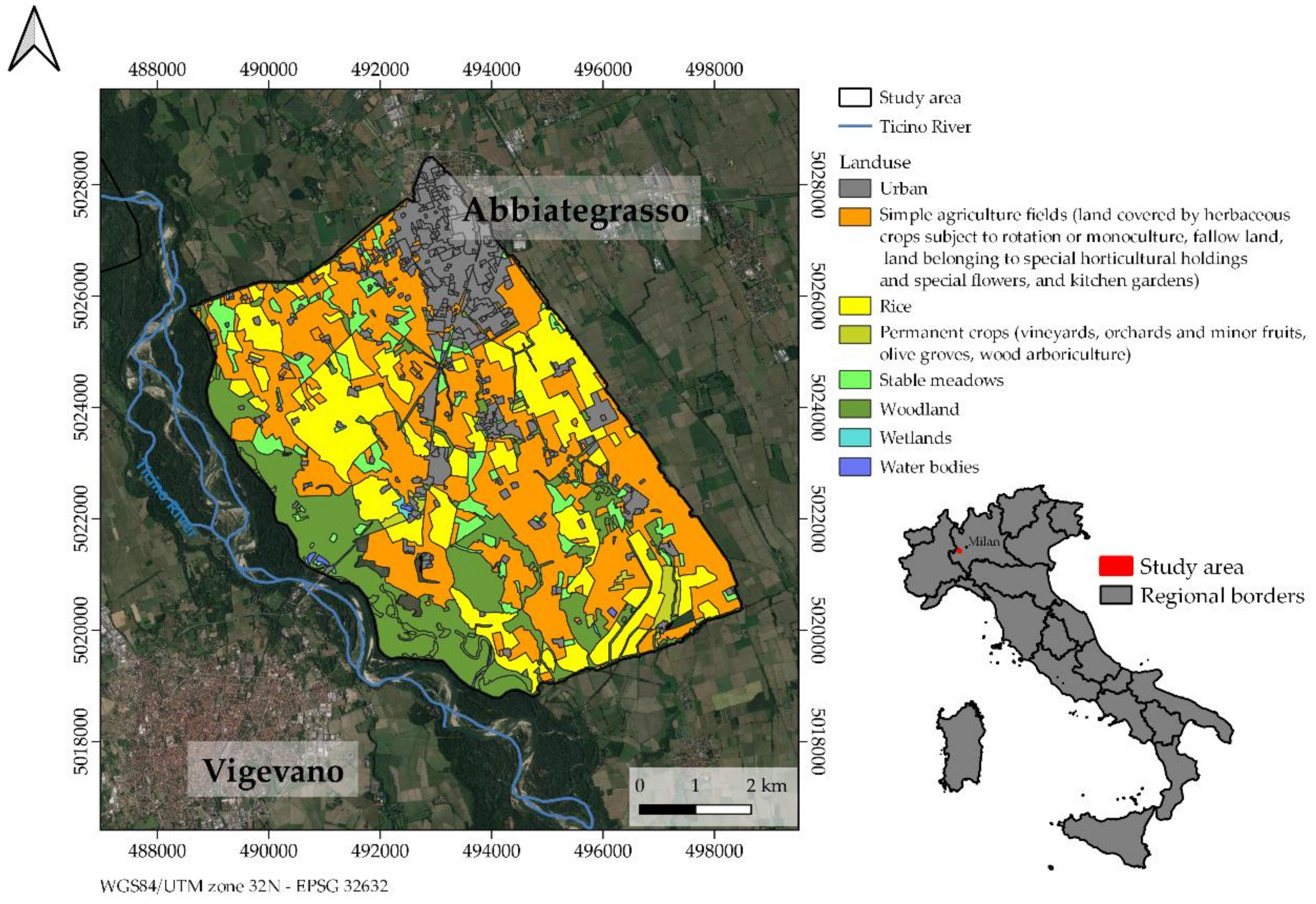
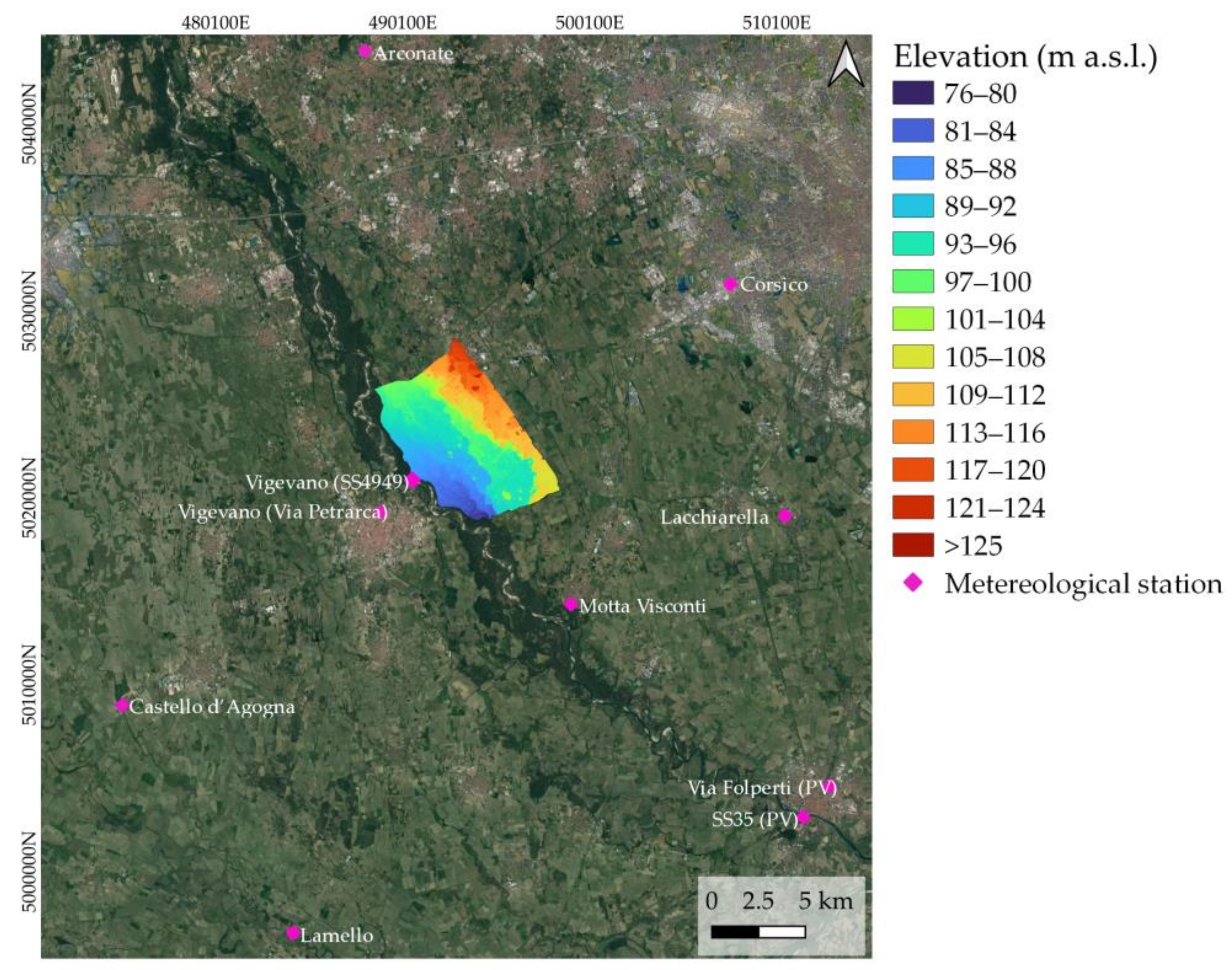

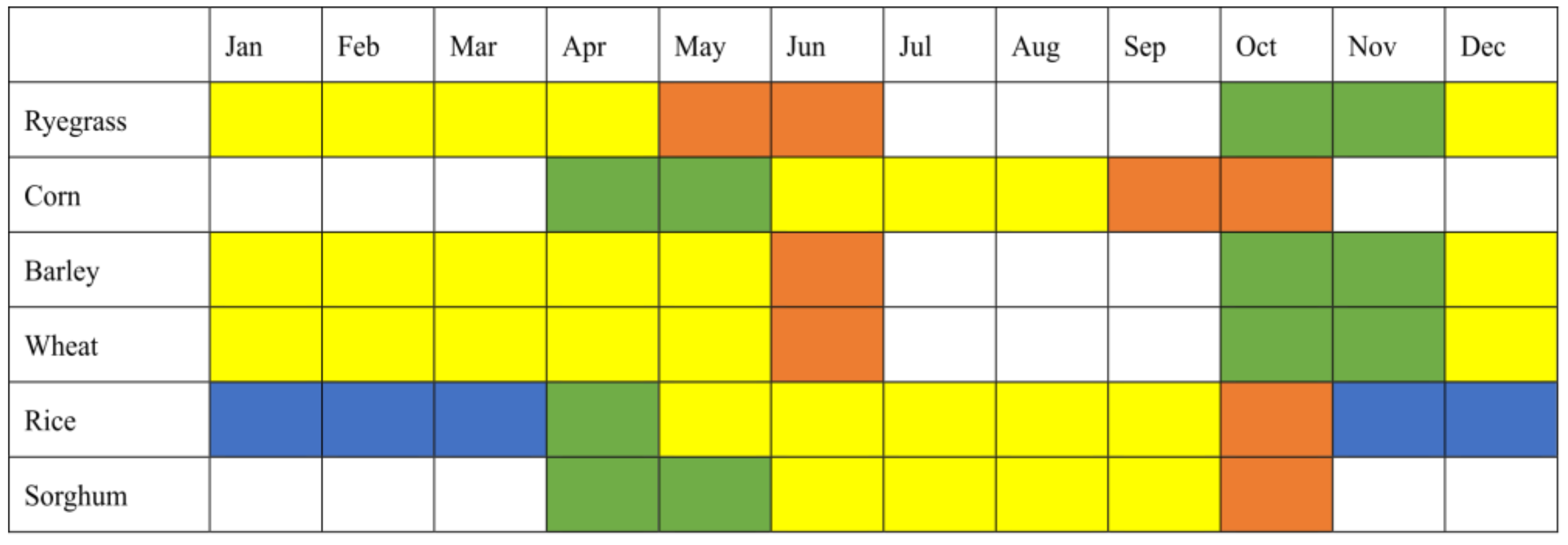
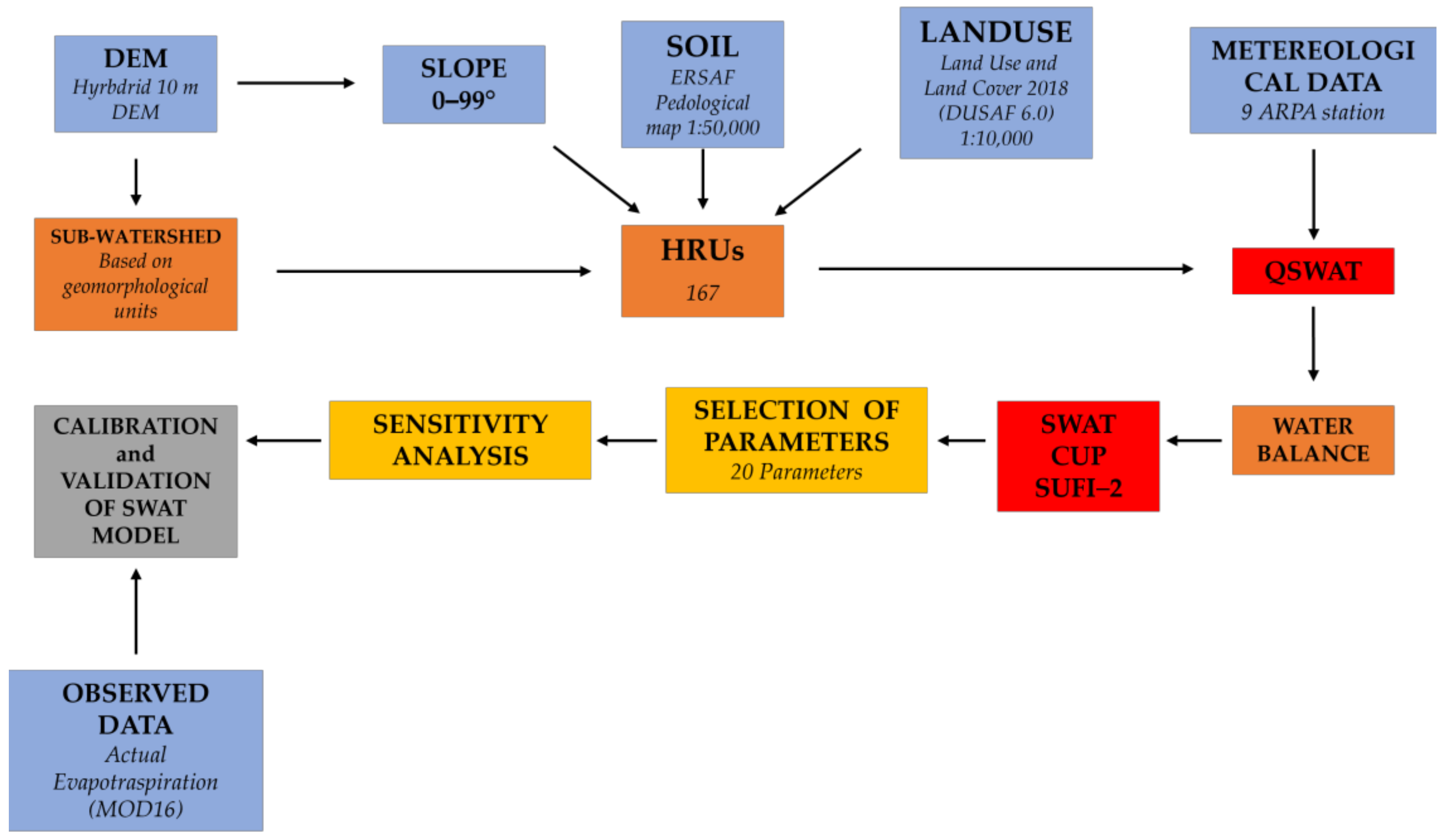
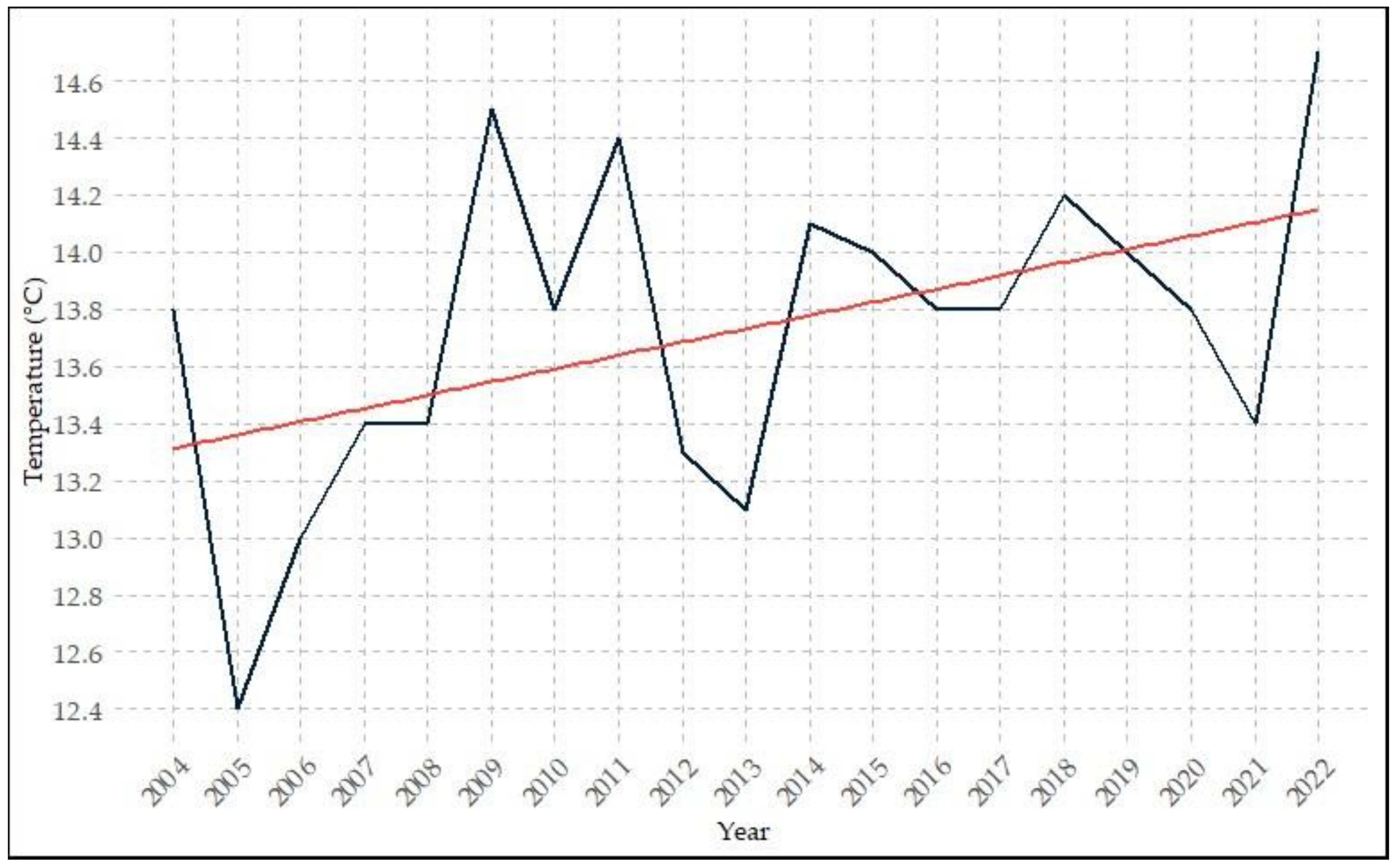
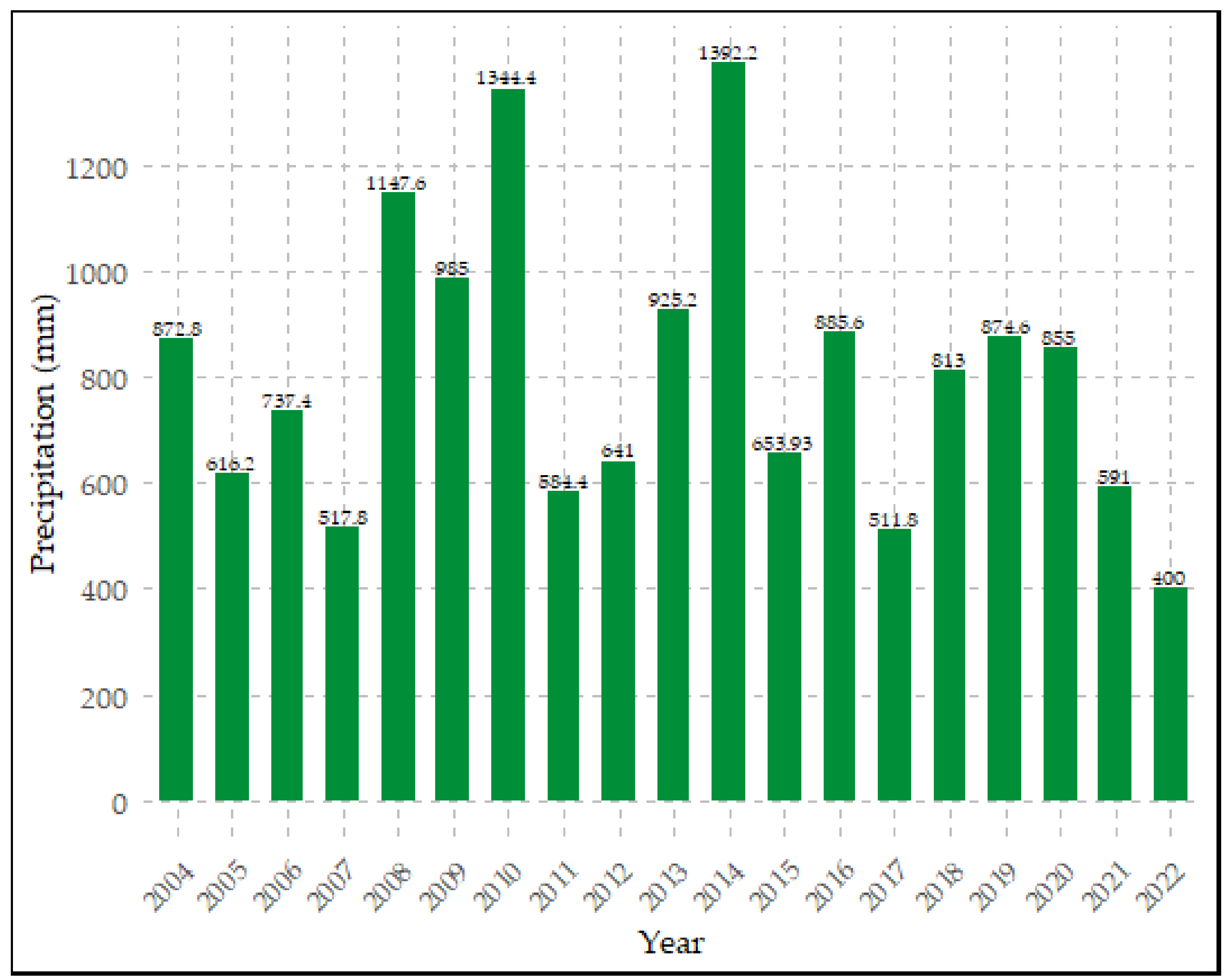

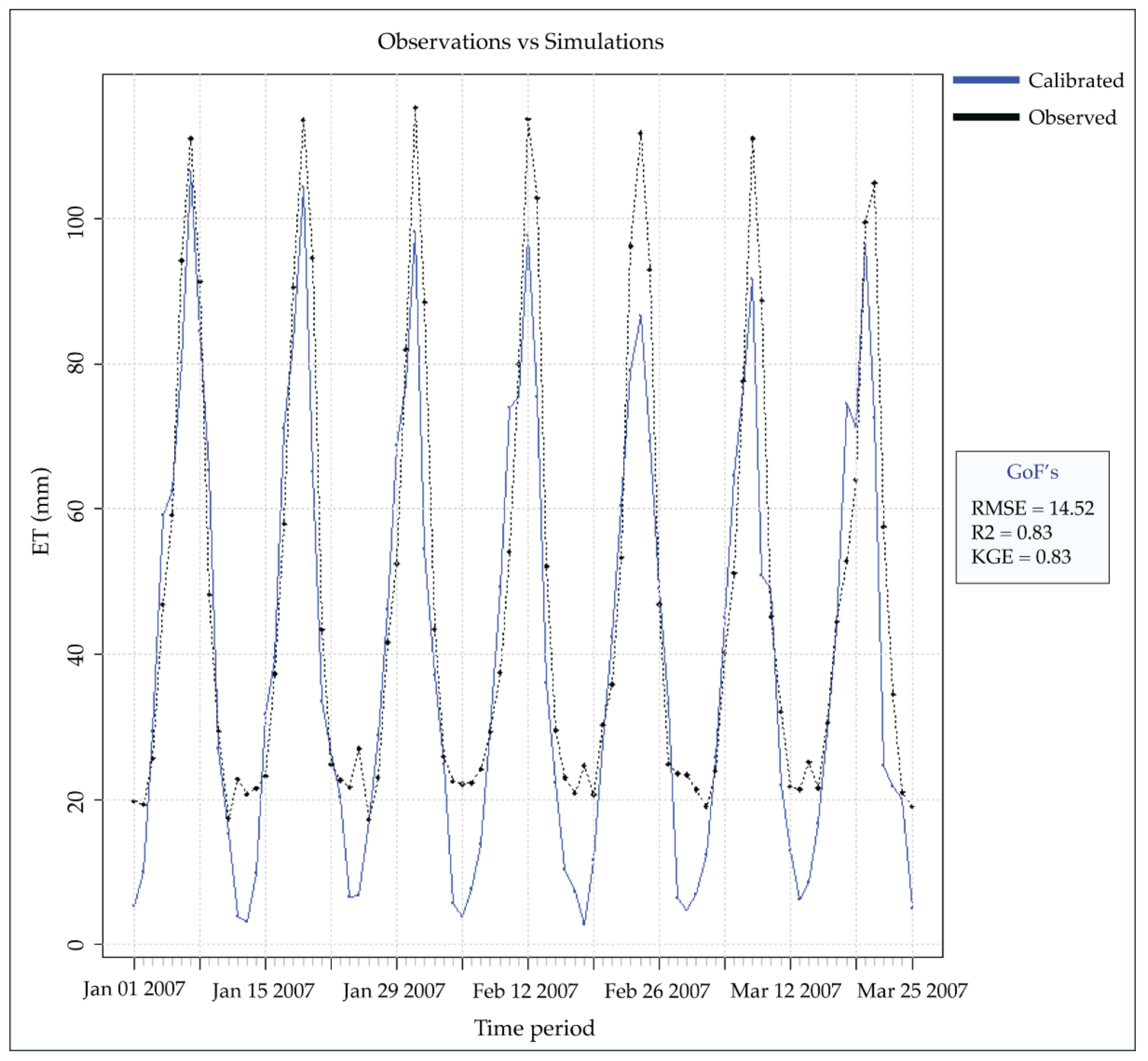
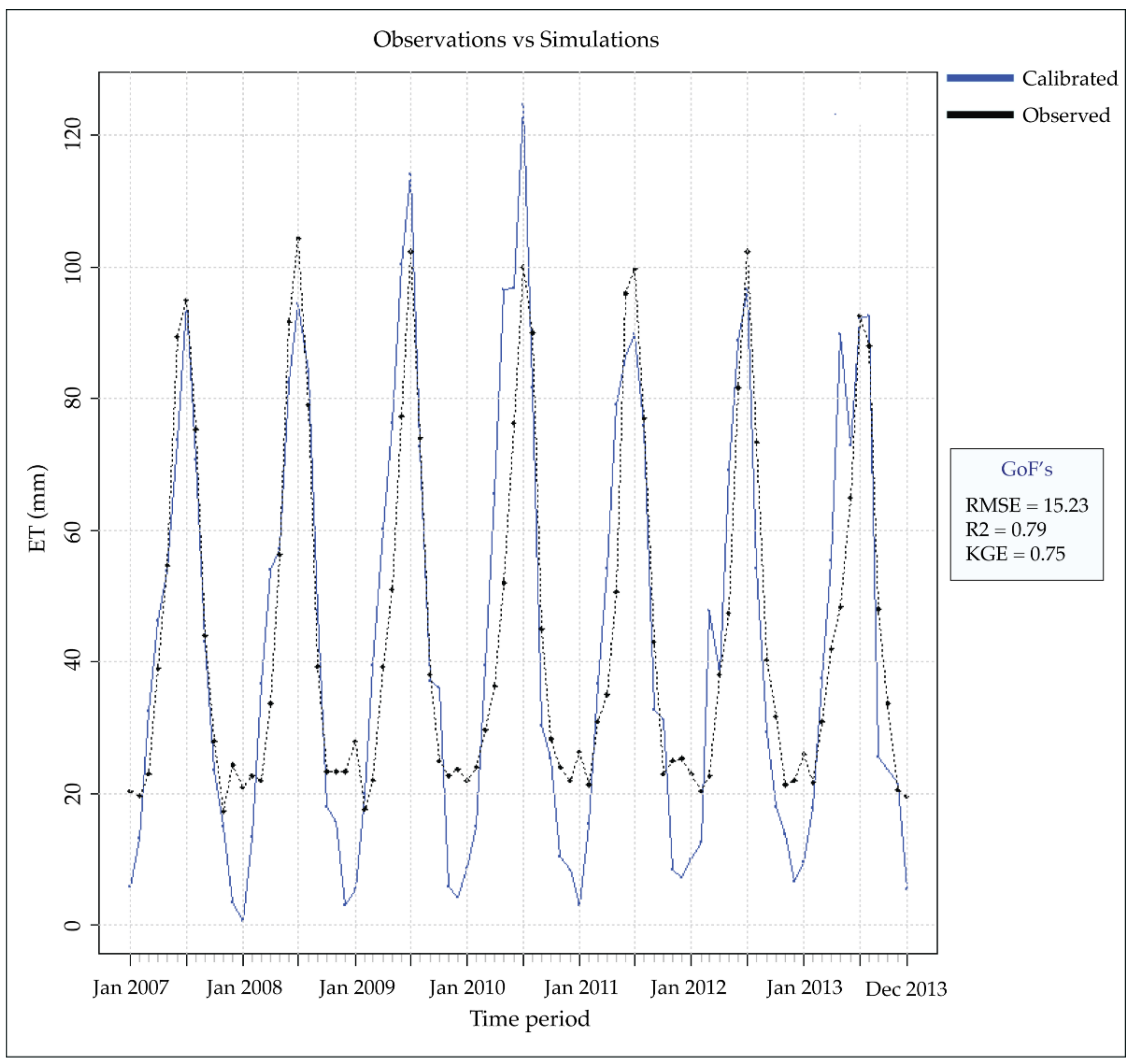


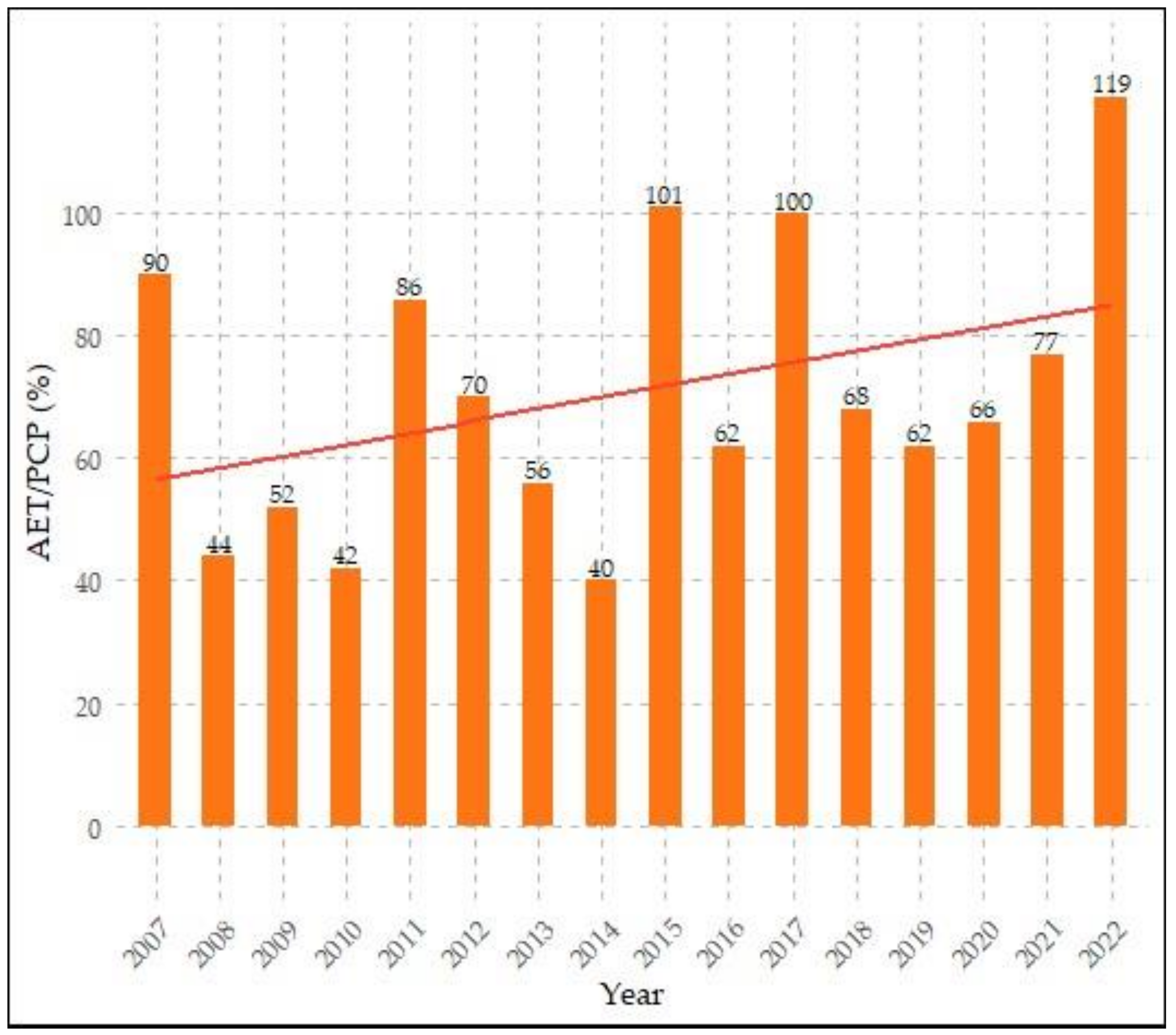
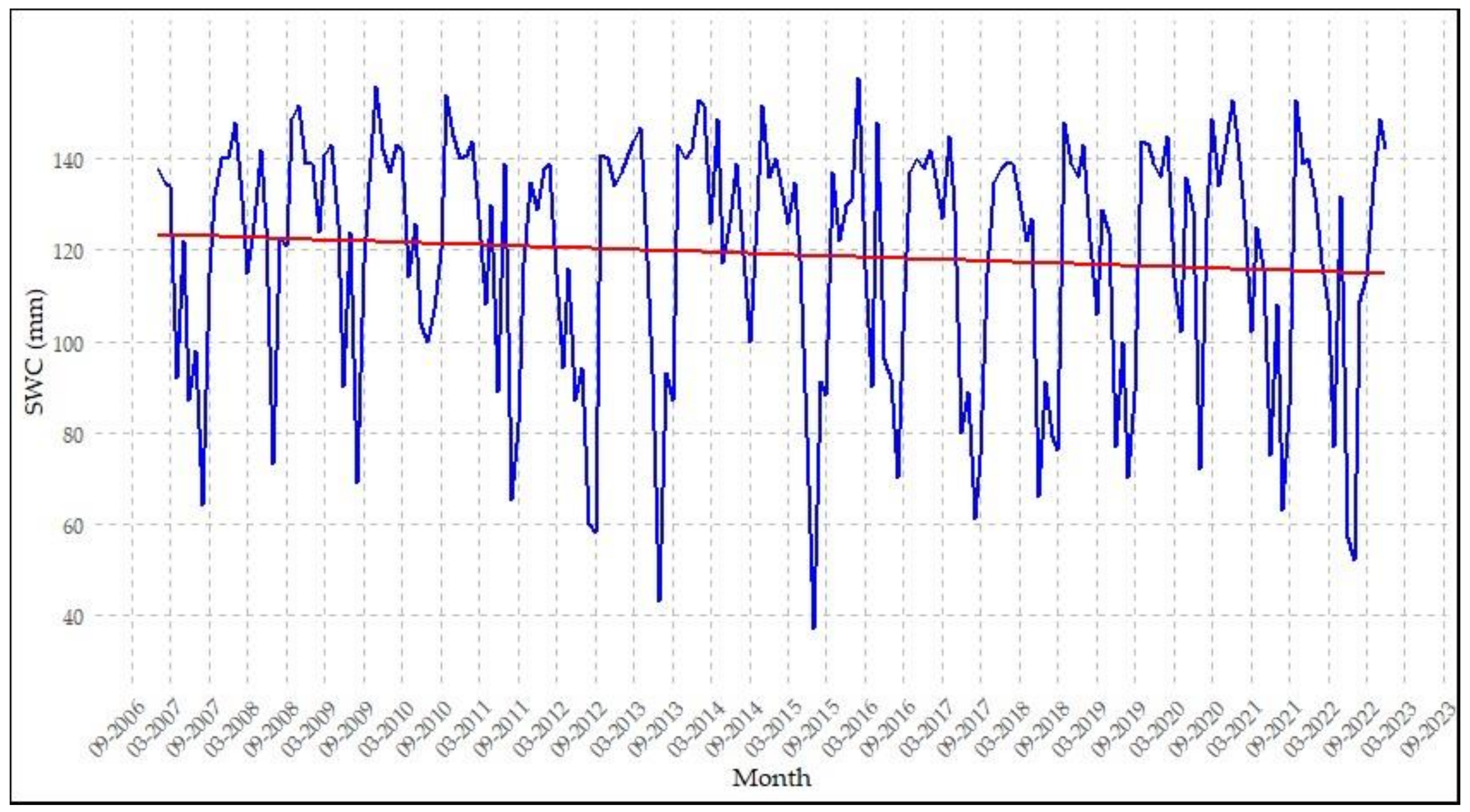
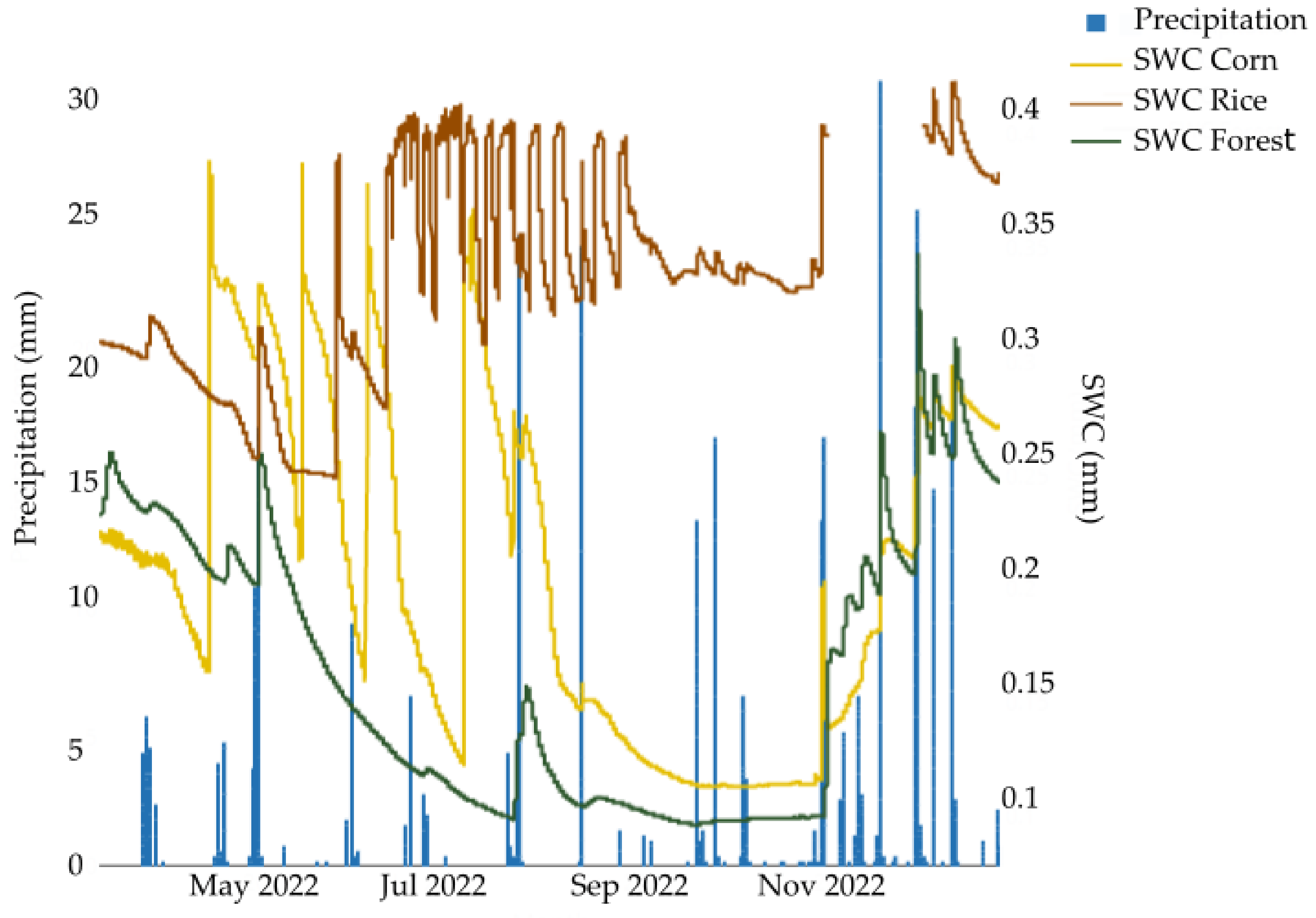
| Data Type | Sources | Resolution and Description |
|---|---|---|
| Topography | Deutsches Zentrum für Luft und Raumfahrt (DLR) and Ministero dell’Ambiente: Geoportale Nazionale, 2019 [46] | 10 m “Hybrid” Digital Elevation Model |
| Soil | Geoportale della Lombardia [47] | 1:50,000, Soil information bases |
| Land-Use | Geoportale della Lombardia [40] | 1:10,000, Land Use and Land Cover 2018 (DUSAF 6.0) |
| Climate | Arpa Lombardia [48] | Daily, ARPA Lombardia hydro-nivo-meteorological data archive. |
| Parameter Name | Min_Value | Max_Value | Description |
|---|---|---|---|
| 1:R__HRU_SLP.hru | 0 | 0.2 | Average slope steepness for overland flow |
| 2:V__ESCO.hru | 0.6 | 1 | Soil evaporation compensation factor |
| 3:R__CN2.mgt | −0.2 | 0.2 | SCS runoff curve number for moisture conditions |
| 4:V__ALPHA_BF.gw | −0.07076 | 0.109 | Baseflow recession coefficient |
| 5:V__GW_DELAY.gw | 0 | 20.281 | Groundwater delay |
| 6:V__GWQMN.gw | 0 | 500 | Threshold depth of water in the shallow aquifer required for return flow to occur |
| 7:V__GW_REVAP.gw | 0.1 | 0.2 | Groundwater ‘revap’ coefficient |
| 8:V__REVAPMN.gw | 143.0484 | 342.720 | Threshold depth for water in the shallow aquifer for revap or percolation to occur |
| 9:V__EPCO.hru | 0 | 1 | Plant evaporation compensation factor |
| 10:V__RCHRG_DP.gw | 0.009108 | 0.336 | Deep aquifer percolation fraction |
| 11:V__CANMX.hru | 9.93414 | 29.805 | Maximum canopy storage |
| 12:R__SOL_BD(..).sol | 0.190512 | 1.571 | Moist bulk density |
| 13:R__SOL_AWC(..).sol | −0.5 | 0.95 | Available water capacity of the soil layer |
| 14:R__SOL_K(..).sol | −0.8 | 0.8 | Saturated hydraulic conductivity |
| 15:R__SOL_ALB(..).sol | −0.03 | 0.2 | Moist soil albedo |
| 16:R__SOL_ZMX.sol | 24.9602 | 141.659 | Maximum rooting depth of soil profile |
| 17:V__SLSOIL.hru | 0 | 150 | Slope length for lateral subsurface flow |
| 18:R__SOL_Z(..).sol | −0.03 | 0.2 | Depth from the soil surface to the bottom of the layer |
| 19:R__SOL_CBN(..).sol | 0.041925 | 0.1855 | Organic carbon content |
| 20:V__FFCB.bsn | 0 | 1 | Initial soil water storage |
| Mean (All HRUs) | 5th Percentile | 95th Percentile | |
|---|---|---|---|
| Calibration | 0.59 | 0.22 | 0.85 |
| Validation | 0.49 | −0.17 | 0.79 |
Disclaimer/Publisher’s Note: The statements, opinions and data contained in all publications are solely those of the individual author(s) and contributor(s) and not of MDPI and/or the editor(s). MDPI and/or the editor(s) disclaim responsibility for any injury to people or property resulting from any ideas, methods, instructions or products referred to in the content. |
© 2023 by the authors. Licensee MDPI, Basel, Switzerland. This article is an open access article distributed under the terms and conditions of the Creative Commons Attribution (CC BY) license (https://creativecommons.org/licenses/by/4.0/).
Share and Cite
Bernini, A.; Becker, R.; Adeniyi, O.D.; Pilla, G.; Sadeghi, S.H.; Maerker, M. Hydrological Implications of Recent Droughts (2004–2022): A SWAT-Based Study in an Ancient Lowland Irrigation Area in Lombardy, Northern Italy. Sustainability 2023, 15, 16771. https://doi.org/10.3390/su152416771
Bernini A, Becker R, Adeniyi OD, Pilla G, Sadeghi SH, Maerker M. Hydrological Implications of Recent Droughts (2004–2022): A SWAT-Based Study in an Ancient Lowland Irrigation Area in Lombardy, Northern Italy. Sustainability. 2023; 15(24):16771. https://doi.org/10.3390/su152416771
Chicago/Turabian StyleBernini, Alice, Rike Becker, Odunayo David Adeniyi, Giorgio Pilla, Seyed Hamidreza Sadeghi, and Michael Maerker. 2023. "Hydrological Implications of Recent Droughts (2004–2022): A SWAT-Based Study in an Ancient Lowland Irrigation Area in Lombardy, Northern Italy" Sustainability 15, no. 24: 16771. https://doi.org/10.3390/su152416771
APA StyleBernini, A., Becker, R., Adeniyi, O. D., Pilla, G., Sadeghi, S. H., & Maerker, M. (2023). Hydrological Implications of Recent Droughts (2004–2022): A SWAT-Based Study in an Ancient Lowland Irrigation Area in Lombardy, Northern Italy. Sustainability, 15(24), 16771. https://doi.org/10.3390/su152416771









